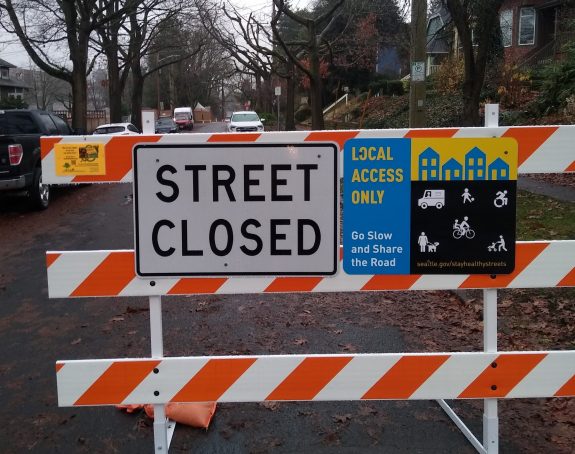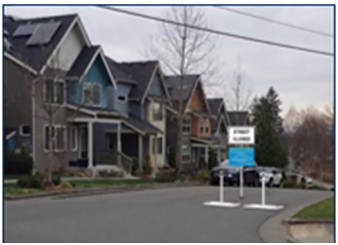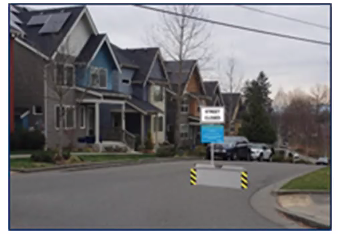Last night the oversight committee for the Move Seattle levy was told that the popular Stay Healthy Streets program will likely have to pause if the Seattle Department of Transportation doesn’t get approval to divert funding from 2.5 miles of neighborhood greenway projects that the department says it’s unlikely to be able to fully complete in the foreseeable future.
In January, the joint Pedestrian and Bicycle Advisory Boards voted essentially unanimously not to divert funding from existing planned bike and street improvements to fund the promise that SDOT and Mayor Jenny Durkan announced last Summer to install permanent infrastructure on twenty miles of Stay Healthy Streets.
SDOT’s Director of Project Development, Jim Curtin, told the committee that the funding source that the department had originally used to stand up and maintain Stay Healthy Streets in 2020, Federal CARES Act funding, has now run out, and that any additional funds used to support the program will be coming from Bicycle Master Plan funding.
The oversight committee did not reach a consensus on whether to approve the funding swap, asking to come back to another meeting to discuss it further. Curtin told the board that if they didn’t find a source for funding, they would have to pause planning future improvements and have to look at whether the department could continue to maintain existing Stay Healthy Streets at all.

During the meeting, SDOT Director Sam Zimbabwe detailed the history of the program, underlining the fact that last Summer when the Mayor’s office and SDOT announced the Stay Healthy Street program would evolve into permanent infrastructure they did not have a funding source identified.
The modal boards are interested in seeing more details of what permanent Stay Healthy Streets will actually entail- most of what was shown at the January meeting to the bike and pedestrian boards were more vision than specifics. Bicycle Advisory Board chair Patrick Taylor suggested that SBAB might be more likely to sign onto SDOT’s proposal if they could see more details on proposed Stay Healthy Street design.
In January, SDOT presented to the Greenwood Community Council on converting the 1st Ave NW Stay Heathy Street and showed some images of possible intersection treatments that utilized Ecoblocks (like the ones currently barricaded in front of the east and west police precincts) or Tuffcurbs to create more of an intersection block than a simple sign. This is one of the first opportunities we’ve had to see proposed design elements SDOT is developing for Stay Healthy Streets.


SDOT is moving forward with plans for Stay Healthy Streets in neighborhoods like Georgetown and South Park as it engages in a bit of a stalemate with these advisory boards. It doesn’t look like they will be proposing any alternate funding sources, suggesting that the Bicycle Master Plan will ultimately be the source of Stay Healthy Streets funding if the other choice is the shuttering of the program entirely.








Comments
4 responses to “Stay Healthy Streets program may be paused if funding swap not approved”
Here’s an honest question: why are road projects meant almost always for car drivers never subjected to this kind of piecemeal budgeting? Has a road project *ever* had to face “cancelation” unless funding was diverted from somewhere else? This stuff is maddening. “We’re going to have to turn off the adaptive signaling project unless we cancel this repaving project somewhere else in the city.” I mean, I’m probably wrong, but it seems like that never happens.
It happens, but only when the cost has a much higher order of magnitude. The Columbia River Crossing in 2016 is the most recent example I can think of.
Even then, within a few years, the money always manages to appear.
Great point, Jort.
Also, how much can these projects possibly cost? There shouldn’t be much of an ongoing expense for these — just leave the barriers in place that are currently there. It seems that pausing the program would cost more, since someone would have to go around and remove all the equipment.
honestly what we need is just for all residential/local roads to be “stay healthy” streets- there shouldn’t have to be a giant orange barrier for drivers to understand that they should stick to the arterials except when they are actually accessing something on that street. We don’t need more studies. We shouldn’t need the blockades. Just make that the general policy.